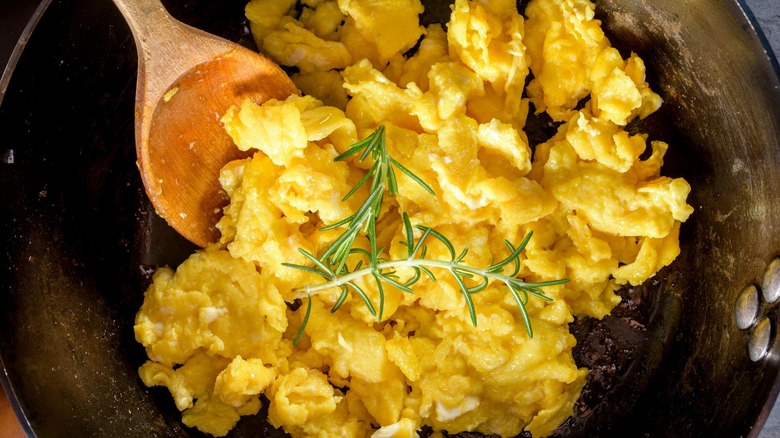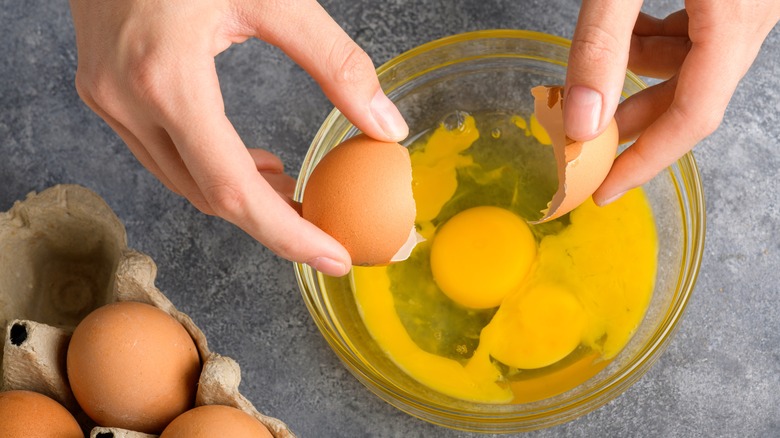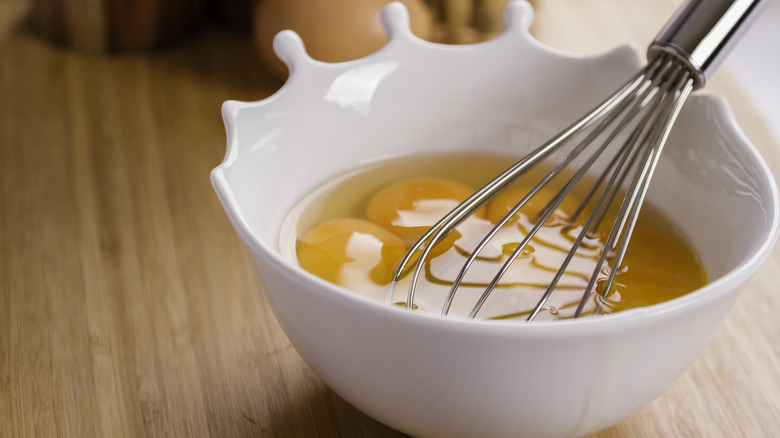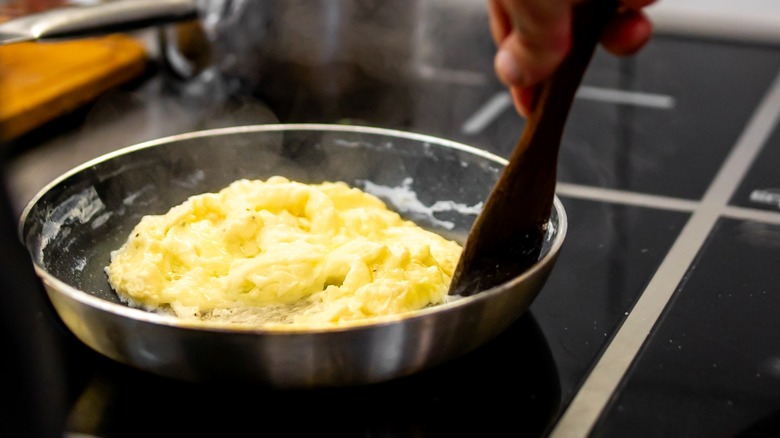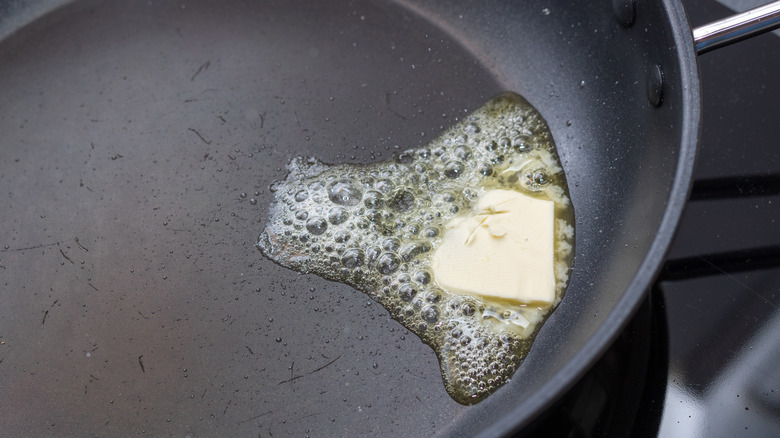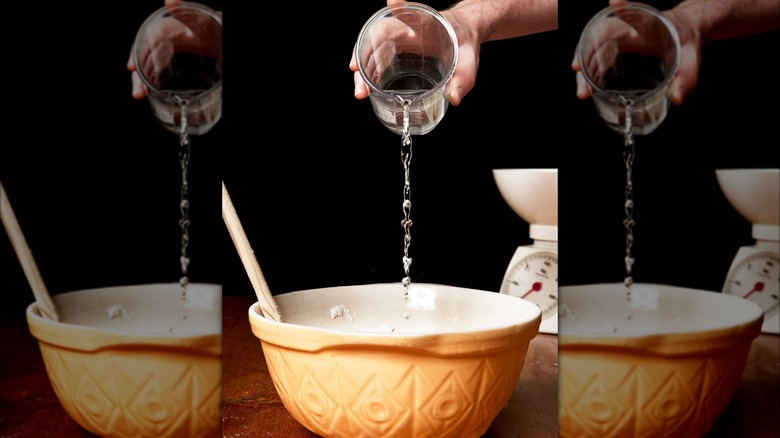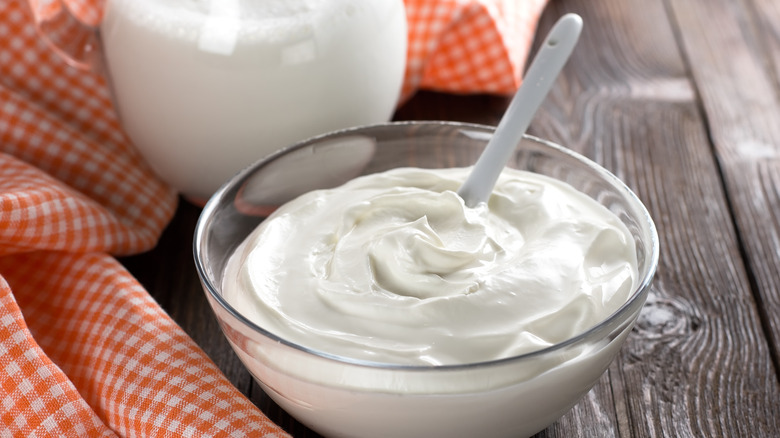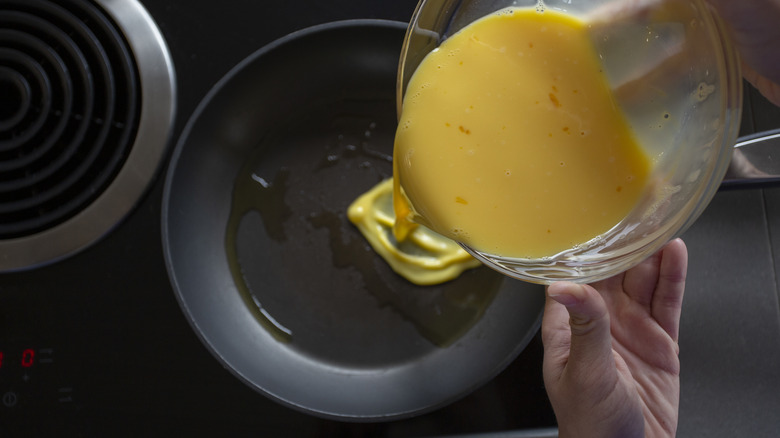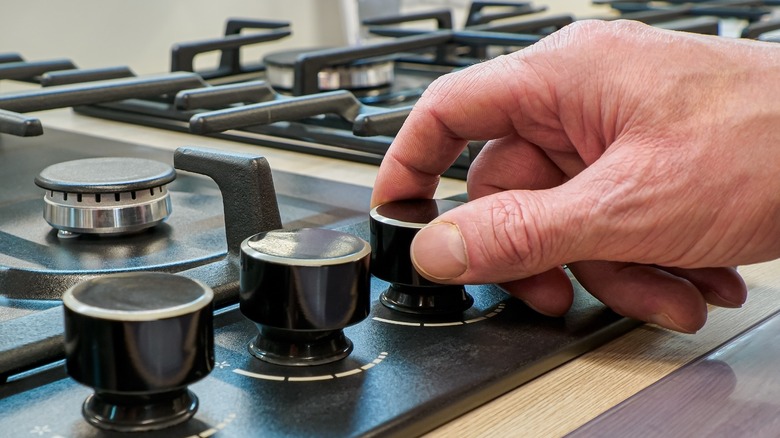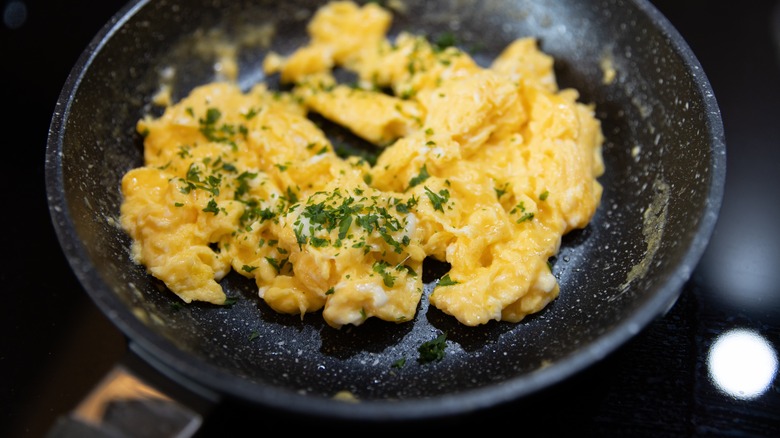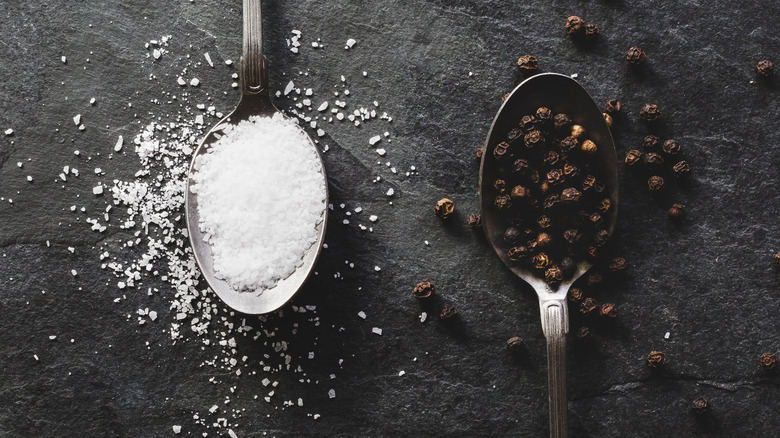Expert-Approved Tips For The Fluffiest Scrambled Eggs You've Ever Tasted
Scrambled eggs are a breakfast staple. However, as you probably already know, sometimes they turn out light and fluffy, while other times they turn out dry or overly wet. Clearly, how they turn out is going to impact their overall taste as well as how satisfied you (and others) are with the meal you prepared.
Preparing fluffy scrambled eggs isn't rocket science, but it isn't as simple as it seems either. You need to know what ingredients will optimize the fluffiest eggs, how to mix everything together, and how to cook them on the stovetop. We reached out to two experts to help us share some of the top tips and tricks for preparing fluffy scrambled eggs. Nelson Serrano-Bahri is a chef and the Director of Innovation at the American Egg Board, and Kyle Mendenhall is the Senior Director of Culinary at Snooze A.M. Eatery. Read on to hear what they had to say and discover what you've been doing right — or wrong — when making scrambled eggs.
Add a few extra egg yolks
One tip improve your scrambled eggs, is to put a few additional egg yolks into the mixing bowl with the full eggs. According to Nelson Serrano-Bahri, "Adding extra egg yolks increases the fat content in the scrambled eggs, contributing to a richer and creamier texture. The additional yolks provide more emulsification, helping trap air and create a fluffier consistency."
After cracking the number of eggs your recipe calls for, Serrano-Bahri says to crack a few more and separate the eggs so you only add the additional yolks to the bowl. This isn't an exact science, but to take advantage of the additional fat and creaminess the extra yolks can add, aim to use about one additional yolk for every four eggs. So, if you're cooking eight scrambled eggs, you would add two more yolks. Also, remember, egg yolk color doesn't really matter, so don't be concerned if the yolks are more orange than yellow or vice versa.
Whisk in the bowl (not the pan)
The last time you made scrambled eggs, did you mix them in the bowl or in the pan? If you've been mixing the eggs in the pan, you've been making a mistake. "Mix your eggs (whites and yolks) well before you add them to a hot pan," explains Kyle Mendenhall, adding, "The yolk and white of an egg cook very differently and will have different textures once cooked."
Nelson Serrano-Bahri explains another reason why whisking first is so important. It ensures the eggs are "aerated, leading to a more uniform and fluffier scramble." While you may question whether it is worth heeding this advice, consider that eggs whisked in the pan will cook unevenly. And, because the eggs won't have been as aerated during the whisking process, they will likely turn out with a much denser texture, compared to eggs pre-whisked in a bowl. Taking a few additional minutes to whisk in the pan will be well worth the time for a fluffy finished product.
Stir constantly and gently
One of the most important keys to fluffy scrambled eggs lies in giving them constant attention as they cook. This is not a dish that you can walk away from. Instead, you must constantly stir the eggs in the pan as they cook. Nelson Serrano-Bahri explains, "Continuous and gentle stirring while cooking scrambled eggs prevents large curds from forming and promotes even cooking, resulting in smaller, tender curds." Serrano-Bahri shares that he moves the eggs around the pan and folds them over softly using a spatula.
Kyle Mendenhall shares similar advice by explaining that "the smaller the curd, the lighter the eggs will be." Mendenhall implements a different approach when stirring his eggs in the pan. Instead of using a spatula, chopsticks are Mendenhall's tool of choice for ensuring a small curd and light, fluffy eggs. Regardless of the utensil you decide to use when cooking your eggs, it's important to follow our experts' advice and stir/fold them continuously.
Butter is key for fluffy scrambled eggs
If you're looking for the fluffiest scrambled eggs, don't skimp on the butter. Both Nelson Serrano-Bahri and Kyle Mendenhall agree on this point by highlighting the important roles butter plays in achieving fluffy scrambled eggs. But, if you usually use milk instead of butter Serrano-Bahri explains that "using butter instead of milk adds fat without introducing additional liquid, which can make the eggs more cohesive and less likely to turn out watery. Butter also enhances the flavor and helps achieve a smooth, velvety texture."
Mendenhall's recommendation, on the other hand, focuses on the end of the cooking process. He says, "I recommend mixing in a tablespoon of butter just before they are finished cooking. This gives the eggs a smooth, tasty texture." You could even consider browning the butter in the pan before adding the eggs to enhance their flavor further.
Add a little water
"Steaming scrambled eggs can also achieve a fluffier result," says Kyle Mendenhall. So, what makes steam? Water, of course. Next time you want to cook up some fluffy scrambled eggs, skip the milk in favor of adding some water.
As Nelson Serrano-Bahri explains, "Adding a splash of water to your beaten eggs can help create steam during cooking, which expands the eggs and makes them fluffier." Don't worry, your eggs aren't going to taste watered down with the addition of just a small amount of water. According to Serrano-Bahri, "Water evaporates quickly, creating pockets of steam that lift the eggs as they cook." He recommends measuring out 1 teaspoon of water for each egg you're preparing for the meal. Be sure to whisk the water with the eggs before you add them to the pan to ensure that it is even distributed.
Add a little sour cream before cooking
Sour cream may not be an ingredient you typically associate with scrambled eggs, but perhaps it is one you should give a closer look. Nelson Serrano-Bahri explains, "Mixing in a small amount of sour cream adds creaminess and tang to the eggs." Beyond the creaminess factor, the sour cream can deliver additional benefits to the eggs, including helping ensure they turn out fluffy and airy.
Serrano-Bahri adds, "The fat in the sour cream helps create a softer texture, while the acidity can slightly break down the egg proteins, resulting in a more tender scramble." You don't want to go overboard by adding so much sour cream that it throws off the texture of your eggs. Serrano-Bahri suggests adding 1 tablespoon of the creamy condiment for every two eggs you're cooking. As with other additions, be sure to whisk the sour cream in with the eggs thoroughly before adding anything to a hot pan.
Use a nonstick skillet
While there are many instances when stainless steel or cast iron shine in the kitchen in terms of performance and the overall taste of the finished product, these cookware types are not the best choice for all recipes. Scrambled eggs are one example of a recipe that will likely turn out much better (and easier for you to prepare) if you cook them with nonstick cookware.
Nelson Serrano-Bahris says, "A nonstick skillet reduces the need for excess fats and ensures the eggs don't stick to the pan, allowing for gentle, even cooking. This results in a smoother, fluffier texture." Who wants to spend tons of time cleaning up a pan covered with stuck-on egg for a meal that wasn't all that fluffy to begin with? Just remember to follow Serrano-Bahri's advice to preheat your nonstick skillet before pouring in the whisked eggs and cooking them.
Cook on low heat
If you're in a rush and need to get out the door or don't feel like standing over a hot stove any longer, you may try to crank the burner up to medium or even medium-high heat when preparing scrambled eggs. However, you could ruin your scrambled eggs if you try this approach. Nelson Serrano-Bahri, explains, "Cooking scrambled eggs on low heat allows them to cook slowly and gently, preventing overcooking and maintaining their moisture." Serrano-Bahri adds, "This technique helps in achieving a soft and creamy texture."
In addition to keeping the eggs moist and creamy, cooking over low heat will also prevent them from cooking too quickly. This means they are less likely to stick to the sides of the pan, dry out as they cook, or, even worse, burn. "Start with a preheated pan over low heat and stir continuously," says Serrano-Bahri.
Remove the eggs from the heat before fully set
A common mistake people make when preparing eggs is overcooking them. As Nelson Serrano-Bahri explains, "Eggs continue to cook from residual heat even after being removed from the stove." This means if you leave them on the burner until they're perfect, they'll cook more once you remove them. By this point, it will be too late, and you'll be left with rubbery, overcooked eggs.
To avoid this problem, Serrano-Bahri advises that you "[take] the eggs off the heat when they are still slightly runny [to ensure] they finish cooking to a perfect, soft consistency without becoming dry." While you don't want your eggs to turn out dry, you also want to make sure they are cooked through and safe to eat to avoid foodborne illnesses. When preparing scrambled eggs, the whites and yolks should not be runny; they should have a firm consistency. Once your eggs have reached this point, Serrano-Bahri recommends removing them from the frying pan and putting them on a plate as soon as they're ready to prevent them from cooking any more.
Season at the end of cooking
Improper seasoning is a mistake people make when preparing many egg dishes, including poached eggs and egg salad. Understanding when — and how — to season your scrambled eggs is crucial. Nelson Serrano-Bahri recommends adding the salt at the end, not the beginning, of the cooking process. He says seasoning at this time in the process "helps to avoid drawing out moisture from the eggs too early, which can make them watery. Seasoning at the end preserves their fluffy texture."
"Once the eggs are almost fully set," says Serrano-Bahri, "add a pinch of salt and other seasonings of your choice." As for which seasonings to add to your fluffy scrambled eggs, it is up to you and your taste preferences! A few to consider include curry powder, tarragon onion powder, garlic powder, paprika, or just some good ol' black pepper. Think about the other side dishes or main courses you'll be serving alongside the eggs and the flavors you and your guests most enjoy to help you choose the best seasonings.
